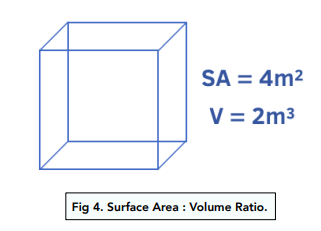Exchange Surfaces - Surface Areas to Volume Ratios (GCSE Biology)
Surface Areas to Volume Ratios
Surface Area: Volume Ratios
We have previously grasped that smaller organisms have a larger Sa:Vol ratio and larger animals have a smaller Sa:Vol ratio. You can calculate and observe this difference.
Calculate Sa:Vol ratio
Divide the surface area by the volume. Therefore, if an organism has a surface area of 4 meters squared and a volume of 2 meters cubed, the Sa:Vol ratio is 2.

Single celled organisms have a very large surface area to volume ratio, however large organisms on the other hand have a greater volume, with a smaller increase in surface area. Therefore, the rate of diffusion would be too slow in large organism to provide all of the transport. Therefore, these organisms require a transport system.
An exchange surface is any part of an organism that allows for the exchange of materials between the organism and its environment. Examples of exchange surfaces in biology include the lungs, skin, and the surfaces of cells in the gut.
The surface area to volume ratio is important in biology because it determines the efficiency of exchange surfaces in the organism. A larger surface area to volume ratio means that there is more surface area available for the exchange of materials, making it easier for the organism to absorb necessary nutrients and eliminate waste products.
As the size of an organism increases, its volume increases faster than its surface area. This means that the surface area to volume ratio decreases as the organism gets larger. This has important implications for the efficiency of exchange surfaces, as larger organisms require a larger surface area to sustain the necessary exchange of materials.
The relationship between surface area to volume ratio and cell size is a crucial one in biology. As cells get larger, their volume increases faster than their surface area, which can make it difficult for the cell to exchange materials efficiently. This is why cells are typically small and often have specialized structures, such as cilia, to increase their surface area to volume ratio.
Organisms can increase their surface area to volume ratio by developing specialized structures that increase the amount of exchange surface available. Examples of these structures include the lungs in mammals, the finger-like projections in the gut of mammals, and the branching structures in the roots of plants.
The significance of surface area to volume ratio in the evolution of organisms is that it has played a role in shaping the size and structure of organisms. As organisms evolved and grew in size, they developed specialized structures to increase their surface area to volume ratio, which allowed them to continue exchanging materials efficiently. This has played a key role in the success of many species and has contributed to their ability to thrive in diverse environments.
The surface area to volume ratio impacts the function of exchange surfaces in different organisms by determining the efficiency of exchange. For example, the lungs of mammals have a large surface area to volume ratio, allowing them to exchange oxygen and carbon dioxide efficiently. In contrast, the surface area to volume ratio of the gut in mammals is much smaller, which can limit the rate of exchange and make it more difficult for the organism to absorb nutrients and eliminate waste products.






Still got a question? Leave a comment
Leave a comment